Artblog pal, Rob Matthews practices his own brand of art activism by passing on names of artists he knows who are either new arrivals in Philadelphia or people whose art he thinks I should know about. I’m always touched by Rob’s drumbeat of enthusiasm and I have yet to be disappointed by his pitches. Recently he told me about Scott Laumann, a former West Coaster who’s here via a network that includes Dayton Castleman and the Church Studios at Mt. Olivet where Castleman had a ministry as well as a studio. Castleman’s now in Chicago getting an MFA at the Art Institute and Laumann is here with a studio in the Church Studios complex, and he and his family — wife, Alicia, and daughter, Paloma — are in the Castleman family’s former apartment.
I paid a visit to Laumann recently and here with some pictures is a distillation of our hour-long talk in a small, chilly studio whose compensation is a wonderful diffuse light through enormous windows.
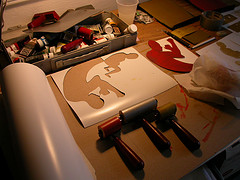
Scott Laumann’s studio. Desk with the print-making materials laid out and waiting.
Demographics
Scott Laumann and family arrived in Philadelphia in August. They’d been living in San Francisco. But the artist, a native Californian, is from San Diego. Alicia Laumann is a dancer and a choreographer who teaches at Rock School of Dance in South Philadelphia. Her father was a missionary and she’s lived all over the world.
Laumann went to school at Northern Arizona University in Flagstaff where he got a BFA in art. After graduation he got a bunch of freelance jobs right away with places like the Detroit Free Press and thought his career was made. But a freelancer’s life is precarious–and dependent on the next job and there’s a whole lot of competition out there and Laumann says that ultimately he had to rely on other things for income — delivering food out of his car; waiting tables and the like. Fed up with that life he returned home to San Diego and continued to work while developing his skills at night. He picked up a few commissions here and there and then decided to make the leap to San Francisco, a place he’d always wanted to live. He took his portfolio to a few place, got work at Netscape which hired him to do pieces online — illustrations, collage-based. And he was happy and stayed in the Bay area.
Studio Practice and Commercial Work
I asked Laumann about his practice which includes commercial illustrations — portrait paintings with collage elements — and a more personal, dreamy studio practice based on abstract concepts and imagery.
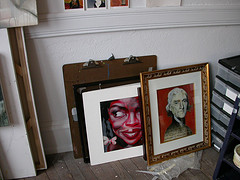
Laumann’s portraits line the floor and sit on the walls of his small studio
The portrait work is for magazines like the LA Times Book Review, Vibe, the Washington Post, Entertainment Weekly, a formidable list. The works are possessed of a formidable brooding presence and they’re richly evocative of people with large personalities.
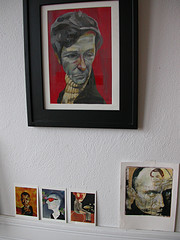
More portraits on his studio wall.
Some of his commercial pieces, however, haven’t been so commercial after all, like the six large jazz portraits he did for an LA jazz club — huge paintings (9’tall) of Charles Mingus, John Coltrane and Miles Davis, Billie Holiday, Bill Evans, Art Blakey and Louis Armstrong. The job was done for a non-profit space that didn’t have the cash to buy the works, so the paintings were shown there but not sold. Laumann has had success translating the images into giclee prints and selling the prints on his website.
About the collage aspects, Laumann said he loves old encyclopedias. He’s collected a bunch from thrift shops here and there and that he could do an entire series based on the old-fashioned imagery and what it projects. He uses collage as a backdrop. It’s texture and layers he said. I notice it in the fragmentation in the faces of his portraits, which slows down the eye and requires you to dig a little deeper into the image.
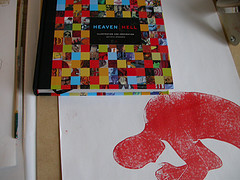
Heaven and Hell is a collaborative book project he worked on. He’d like to be involved in more book projects he said.
New Work
About his studio work, he said he’s in transition now and the move across the country with a 20-month old child has revealed a lot. He’s interested in making books and working collaboratively and in fact that’s one of the things that brought him to Philadelphia–the prospect of having a close working community with collaborative possibilities at Church Studios. That hasn’t happened as much as he’d hoped he said although the group of artists does get together weekly to talk.
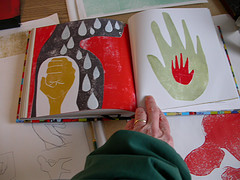
Laumann’s book pages in Heaven/Hell.
For a person whose commercial work involves portraiture, it seems natural that his studio practice would go off into more inward-looking directions. His prints, which he makes using a stencil system cutting the stencils out of refrigerator magnet sheeting then inking them and pressing them on paper, have a delicacy and otherworldliness that is as dreamy as his portraits are concrete and worldly. That said, he did a studio series based on faces and hands, influenced by reading The Divine Conspiracy by Dallas Willard who talks about faces and hands revealing the spiritual nature of a person.
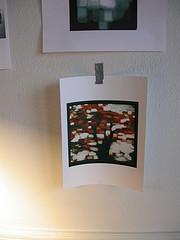
Taped to the wall are photos of his new work in progress based on photographs that have been digitally altered. The images are then worked up into paintings. Raoul de Keyser comes to mind in some of these works whose real world references are reduced to signs and shapes that evoke and conjure rather than depict the world.
His newest work is playing with issues based on digital photography, pixillation, and the idea of ambiguous imagery and how the mind makes a leap to deconstruct and understand an image even when very little information is given. I think this series will be most interesting, and in a way, it accomplishes the feat of integrating his photo-based, real world oriented commission works with his deeply personal/intellectual and spiritual studio practice. I look forward to seeing them progress.
The Westerner
Laumann, who’s never lived in the East of the US before but was always fascinated by this part of the country sounded like his fascination has crashed down to the reality of life in a big post-industrial city that is unlike California the way the moon would be unlike Mars. Now he knows how much of a westerner he is, he said.
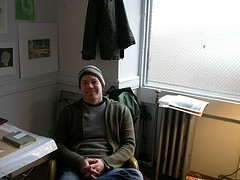
Scott Laumann, wearing three layers of long sleeves and a hat in his small but beautifully lit Church Studios space.
Church Studios
When I asked whether the artists in the complex had to spend time with the congregation as part of their commitment to being housed in the church’s studios, he said no. None of them attend church there and they have very little interaction with the congregation. He said he thought the interesting thing about the artists was that none of them is doing anything overtly Christian in their work. That said, many of them make work that is highly internalized and focused on human and spiritual concerns.
[Ed. note: Scott wrote me to clarify that last paragraph about the congregation/artist interaction: Here’s what he said:
As far as the interaction with the congregation, although we don’t have much direct contact, I know we are trying to help them understand what we are working on as artists and we all try to serve the church’s needs with specific chores, etc. I just didn’t want to misspeak as the new guy!]
Laumann’s studio practice, like all artists’ studio practice can’t help but be affected by things outside the studio. It’s important to let the real world in. And I like the way Laumann is doing so in his new works that blend the worlds of computer, painting and photography and ask the viewer to look at the universals and not the specifics for meaning. It’s cool stuff and deep stuff.
Studio Out-take
The Church Studios will have an open studio event at the end of March, so look out for that.
And because we all love a little bit of gossip with our studio visits, here’s something Laumann told me about Jas Knight, who’s got a studio in the complex. Knight, whose work we’ve seen at Seraphin and elsewhere, is moving to New York and will be working as one of Jeff Koons‘s studio assistants. That makes three Philadelphians working for Koons that we know of, Knight, Nathan Wasserbauer and Matt Likens who just emailed that his model of the proposed Koons locomotive sculpture for LACMA was on view at the Museum recently — that is, on view via photo and a short movie.





